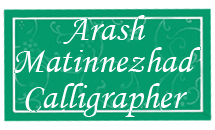History of nastaliq
History of Nas’taliq:
It was about 10 th century that “Ebn-e-Moqlah Beyzavi Shirazi” conducted a research and studied six major calligraphy styles and categorized them. These styles were “Mohaqqaq”, “Reyhan”, “Sols” or “Thuluth”, “Naskh”, “Reqaa”, and “Towqee”. All of these calligraphy styles followed 12 major principles. After “Ebn-e-Moqlah” another calligraphy master named “Hassan Farsi Kateb” combined “Naskh” and “Reqaa” styles and invented a new style, called “Taliq”. Eventually in the 14th century, “Mir Ali Tabrizi” combined two major scripts of his time i.e. Naskh and Taliq and created the most attractive Persian Calligraphy style, “Nas’taliq”.
Why Nas’taliq is Different?
It is really important to note that unlike its ancestors, Nas’taliq follows natural curves. In other words, unlike Arabic scripts that follow logical/geometrical designs, Nas’taliq follows the nature and natural curves. There are a lot of resemblances found between the curves used in Nas’taliq and natural curves and a few examples are shown here. It is interesting that it may not be the preliminary intention of Mir-Ali or the others to write the letters in such a form that they look like natural curves; but rather later these similarities have been found. Therefore, it shows that it is because of the initial spirit of Nas’taliq and its tendency toward nature that it looks so intimate and beautiful.
